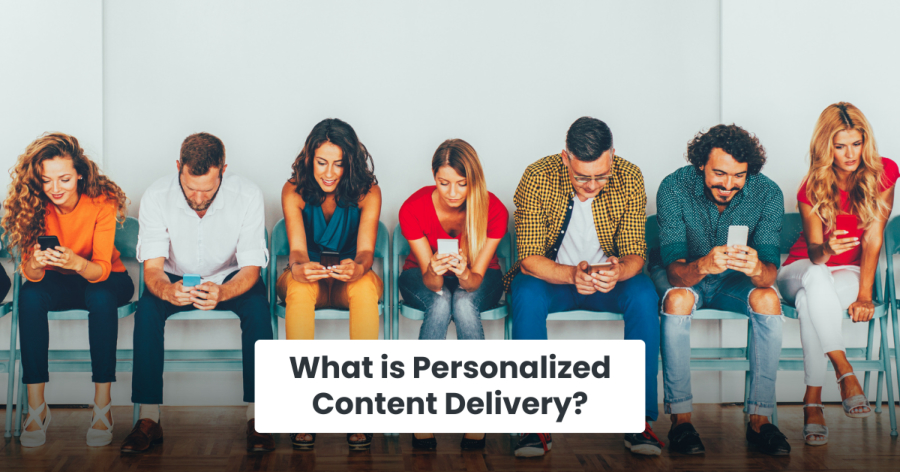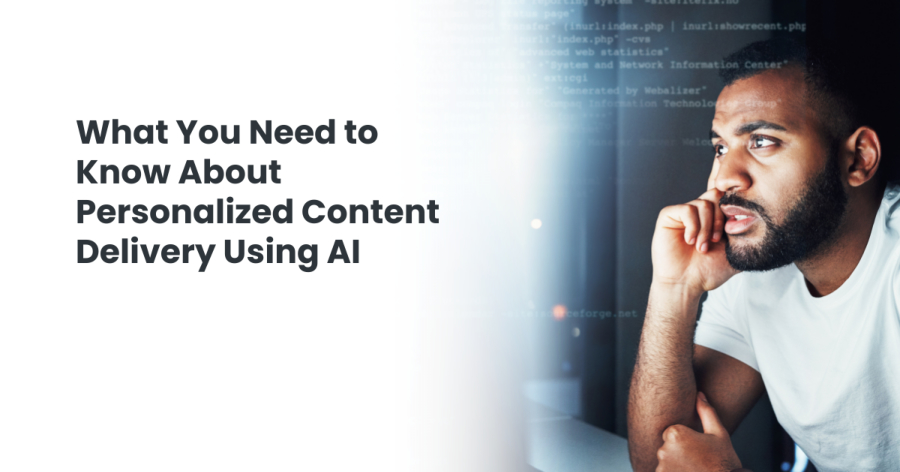“Nowadays, standing out and engaging with your audience has become challenging. Especially with the continuous rise and development of the digital landscape. The question is, “How to be relevant and trending?” That is where personalized content delivery using AI comes in.”
Imagine living in a world where everything you encounter relates to your interests. A world that makes you feel as though it’s meant only for you. That’s the power of tailored content delivery using artificial intelligence (AI).
Artificial intelligence revolutionizes content delivery strategies. You can create engaging, relevant experiences by using AI.
In this blog, we will dive into personalized content delivery using AI. We will explore its significance in enhancing user experiences and transforming content strategies.
Key Takeaways
- Personalized content delivery is important to engage modern audiences. It offers tailored experiences that resonate with individual preferences.
- AI plays an important role in transforming content delivery. Enables you to create customized experiences that drive user engagement and satisfaction.
- AI algorithms use user data to create personalized content.
- Provide user behavior-optimized content through machine learning and natural language processing.
- Integrating AI into content delivery strategies is key to leveraging personalized experiences.
- Expect the trends in AI-driven personalization and adapt and innovate.
What is Personalized Content Delivery?

It involves creating content tailored to the user’s specific behavior, preferences, and characteristics. It uses data insights and AI-powered algorithms to customize each experience. It helps identify user’s interests, past interactions, and demographics.
When you personalize content, you can provide users with engaging and timely content. Include product recommendations, relevant articles, or any type of content that appeals to your users.
The Evolution of Content AI Personalization and Impact on User Satisfaction
Content AI personalization has evolved since the early days of digital marketing. From using basic segmentation techniques to target specific audience segments. Advancements in technology, particularly AI and machine learning, have transformed content personalization. Especially since it enables dynamic, real-time customization at scale.
Personalized services continue to become popular in the internet world. Thus, more people are expecting personalized experiences across all digital platforms. That’s why as a brand you must continue to deliver relevant and personalized content. Not only that, you should aim to create meaningful interactions with the users.
The information overload theory suggests that user satisfaction increases when content recommendations align with their interests.
That’s why in a world where attention is a scarce resource. Personalized content delivery is your partner! It’s a powerful tool for you to cut through the noise and connect with your target audience on a deeper level.

What are the Benefits of Personalized Content?
Now that you know what content personalization is, it’s time to dig deeper into how it can help your consumer and you as a brand.
Benefits For Consumers
- Relevant Content: Access to relevant information affects user satisfaction. Because of this consumers save time and effort needed to find what they’re looking for.
- Time-saving: Content personalization helps users by presenting relevant content upfront.
- Discovery: It also helps consumers to have access to new products and content that they can’t find on their own.
- Convenience: AI personalization gives user access to content based on their location and device.
Benefits For Businesses
Improved User Experience
Because you know what their interests are, you can connect and engage with your consumers more. Giving them a great user experience. Remember, users are more likely to return to your app or store if you offer something they find valuable.
Increased User Engagement
Personalized content captures users’ attention and encourages them to interact with the content. This leads to higher engagement rates.
You can do this by hopping on to trends or the latest news and creating content out of it.
Higher Conversion Rates
By delivering personalized content that resonates with users, businesses can increase conversion rates. Personalized product recommendations, offers, and content can drive users to make purchases. Or take desired actions.
Enhanced Customer Loyalty and Trust
Be consistent in putting out content that understands their needs and preferences. Keep them coming back for more. This will foster a sense of loyalty.
Providing personalized content shows that you value your users. This also helps build trust and credibility with users.
Better Targeting and Data Insights
Personalized content allows businesses to target specific audience segments more.
AI personalization helps you reach your target audience. You can use AI algorithms and machine learning to get the data you need. It generates valuable data insights about user behavior, preferences, and interactions.
Then, tailor your content to different user groups and demographics.
Competitive Advantage
Businesses that implement personalized content strategies gain a competitive edge in the market. Personalization can differentiate a brand from its competitors and attract and keep customers.
Increased Revenue
Personalized content can lead to higher revenue generation for businesses. Drive sales and revenue growth through targeted offers, recommendations, and content.
Overall, personalized content offers a win-win situation for both users and businesses. It enhances user experiences and increases engagement and conversions. And fosters long-term relationships with customers.
What is the Role of AI in Personalized Content Delivery?
AI helps understand user preferences, predict their actions, and suggest relevant content. Here’s how personalized content delivery using AI works:
Collect and Analyze User Data
AI algorithms collect and analyze user data. You can use browsing history, search queries, demographics, etc. to construct user profiles.
User Profiling
AI generates comprehensive user profiles based on the gathered data. You can use these profiles to better understand a user’s preferences, interests, and behaviors.
Content Recommendation
AI systems make customized content recommendations to each user based on their user profiles. This can contain suggested products, articles, playlists of music, suggested movies, and more.
Real-time Personalization
AI learns from user interactions and comments. Users will always see the most relevant content thanks to this real-time customization.
A/B Testing and Optimization
Use AI to conduct A/B testing to optimize content delivery strategies. AI helps in identifying the most effective personalized content strategies.
Scalability and Efficiency
AI enables personalized content delivery at scale. Allows you to deliver customized content to a large number of users efficiently and effectively.
By harnessing the power of AI, personalized content delivery becomes more dynamic, accurate, and engaging, leading to improved user experiences, increased engagement, higher conversions, and enhanced customer loyalty.
What are the Types of AI Technologies Used in Personalized Content Delivery?
Machine Learning
Analyzes user data, builds user profiles, and predicts user preferences. These algorithms are for content recommendation, user segmentation, and personalized content delivery.
Natural Language Processing (NLP)
Analyzes text data such as user reviews, comments, and interactions with content. NLP helps in understanding user sentiment, preferences, and intent. Use it to personalize content recommendations.
Collaborative Filtering
Analyze user behavior and preferences to recommend content based on similarities between users. This approach is commonly used in recommendation systems to personalize content delivery.
Content-Based Filtering
It recommends content based on the features of the content itself and the user’s past interactions with similar content.
Deep Learning
Deep learning techniques, such as neural networks, analyze complex patterns in user data. Helps make more accurate predictions about user behavior.
Reinforcement Learning
Helps optimize content delivery strategies by learning from user interactions and feedback. This approach helps in continuously improving personalized content recommendations over time.
Predictive Analytics
It forecasts user behavior and preferences based on historical data. Predictive models help in anticipating user needs and delivering personalized content proactively.
Best Practices for Successful Personalized Content Delivery
Know Your Audience
First things first, you gotta understand who you’re talking to. What do they like? What are their interests? The more you know about them, the better you can create content they’ll love.
Create Tailored Content
Once you know your audience, make sure your content speaks to them. Use their language, address their needs, and make it feel like you’re talking directly to them.
Use Data Wisely
Data is your friend! Look at what your audience is clicking on, reading, and sharing. This info can help you figure out what they want more of.
Be Consistent
Keep your style and tone consistent across all your content. This helps build trust with your audience and makes them feel like they know what to expect from you.
Engage with Your Audience
Don’t just talk at them—talk with them! Encourage comments, ask questions, and listen to what they have to say. Building a relationship with your audience is key.
Test and Learn
Don’t be afraid to try new things! Test different types of content, see what works best, and learn from it. This way, you can keep improving and giving your audience what they want.
Stay Authentic
Be yourself! People can tell when you’re being genuine, so stay true to who you are. Authenticity goes a long way in building a connection with your audience.
Remember, personalized content is all about making your audience feel special and understood. So, keep these tips in mind, and you’ll be on your way to delivering content that resonates with the people you’re trying to reach!
Conclusion
In conclusion, delivering personalized content successfully is all about knowing your audience. Create content that speaks to them. Use data wisely. Engage with your audience and stay consistent. Don’t forget to test and learn, and above all, stay authentic.
By following these, you can build strong connections with your audience, provide value to them, and create content that truly resonates. So, go ahead, put these tips into action, and watch your personalized content strategy thrive!




